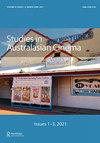Essays from the inaugural Screen Studies Association of Australia and Aotearoa New Zealand conference (2016)
IF 0.7
0 FILM, RADIO, TELEVISION
引用次数: 0
Abstract
The essays gathered in this issue of Studies in Australasian Cinema are selected from, and broadly representative of, the methods and topics brought together at the inaugural SSAAANZ conference. Collectively, the essays speak to a broad conception of screen studies and diverse critical concerns across film and television exhibition and reception, documentary film, pedagogy and screen culture. Constantine Verevis and Deane Williams’ article analyses the cultural history of Melbourne’s Australian Centre for the Moving Image (ACMI). Tessa Dwyer offers a detailed examination of the acclaimed television series Top of the Lake and the role cultural specificity and the authentic voice play in the context of transnational television. Simon Sigley investigates cinematic shifts in how Western Samoa was represented in three feature-length documentary films. Produced by the National Film Unit (NFU) of New Zealand between 1947 and 1962, the films cover a period during which ‘Samoa was administered as a United Nations (UN) trust territory by the New Zealand government’. Derived from a primary survey, Toija Cinque and Jordan Vincent’s article investigates the use of smart TVs and broadband-enabled mobile media devices for the viewing of movies, television programs and documentaries among other forms of screen content, often concurrently with social media devices, to understand audience practices in an increasingly fragmented mediascape. Vejune Zemaityte, Deb Verhoeven and Bronwyn Coate draw on big data in relation to feature film screenings and box office figures to interrogate the ‘10 per cent rule’ – the often made, but untested, claim in industry discourses that the Australian market represents 10 percent of the theatrical market for Hollywood films. Focussing on both Australian and US screening data from 2013, the article compares the popularity of selected American films in both the Australian and US markets to ‘contrast the differences that emerge in terms of distribution and exhibition’. Finally, Mark Ryan examines the pedagogy of screen content in undergraduate Australian screen studies courses. Together, the essays collected here provide a sense of the vibrancy and diversity of the research from the inaugural conference of Screen Studies Association of Australia and Aotearoa New Zealand, and anticipate its second conference, The Uses of Cinema: Film, Television, Screen, Monash University, Melbourne, November 21–23, 2018.首届澳大利亚屏幕研究协会和新西兰奥特亚会议论文(2016)
本期《澳大拉西亚电影研究》的论文选自首届SSAAANZ会议上的方法和主题,并广泛代表了这些方法和主题。总的来说,这些文章阐述了屏幕研究的广泛概念,以及电影和电视展览与接待、纪录片、教育学和屏幕文化中的各种批判性关注。Constantine Verevis和Deane Williams的文章分析了墨尔本澳大利亚运动图像中心(ACMI)的文化历史。Tessa Dwyer详细介绍了广受好评的电视连续剧《湖之巅》,以及跨国电视背景下的角色文化特色和真实的配音。西蒙·西格利调查了西萨摩亚在三部长篇纪录片中的表现方式。这些电影由新西兰国家电影局(NFU)于1947年至1962年间制作,涵盖了“萨摩亚作为联合国(UN)托管领土由新西兰政府管理”的时期。Toija Cinque和Jordan Vincent的文章来源于一项初步调查,调查了智能电视和宽带移动媒体设备在观看电影、电视节目和纪录片以及其他形式的屏幕内容时的使用情况,通常与社交媒体设备同时使用,以了解在日益分散的媒体环境中观众的做法。Vejune Zemaityte、Deb Verhoeven和Bronwyn Coate利用与故事片放映和票房数据有关的大数据来质疑“10%规则”——行业话语中经常提出但未经测试的说法,即澳大利亚市场占好莱坞电影院线市场的10%。文章聚焦于2013年澳大利亚和美国的放映数据,比较了选定的美国电影在澳大利亚和美国市场的受欢迎程度,以“对比发行和放映方面出现的差异”。最后,Mark Ryan考察了澳大利亚本科生屏幕研究课程中屏幕内容的教学法。这里收集的论文共同提供了澳大利亚和新西兰电影研究协会首届会议研究的活力和多样性,并预计其第二届会议“电影的用途:电影、电视、屏幕”将于2018年11月21-23日在墨尔本莫纳什大学举行。
本文章由计算机程序翻译,如有差异,请以英文原文为准。
求助全文
约1分钟内获得全文
求助全文

 求助内容:
求助内容: 应助结果提醒方式:
应助结果提醒方式:


